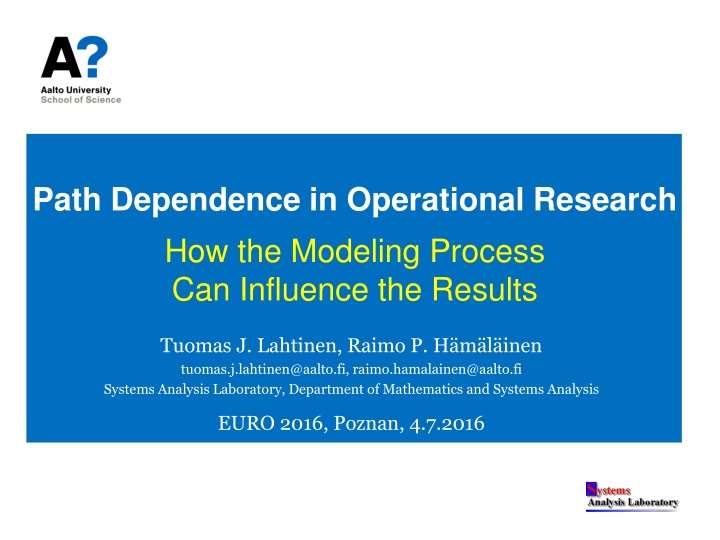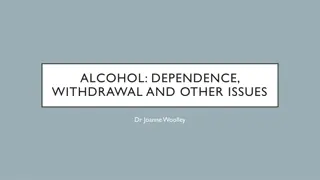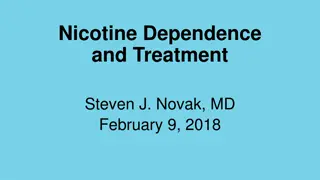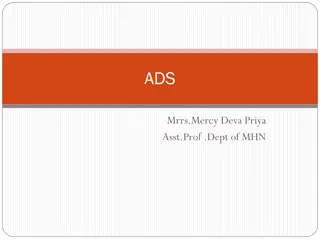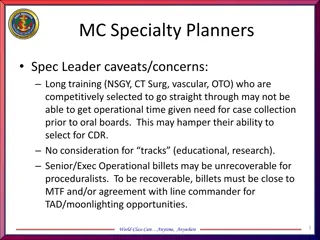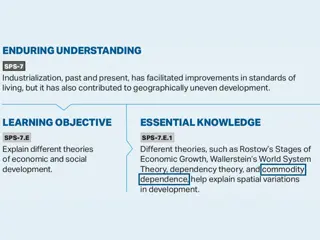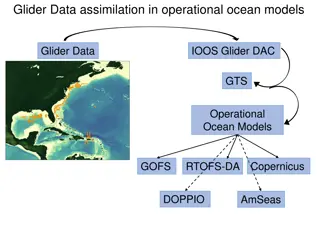Path Dependence in Operational Research: How Modeling Influences Results
This article discusses the concept of path dependence in Operational Research, highlighting how the modeling process can significantly impact the outcomes. It emphasizes the importance of understanding the sequence of steps taken in modeling efforts and the factors that influence decision-making paths. The document also explores the role of paths in multi-criteria methods and negotiation processes, shedding light on how choices and initial points can shape outcomes. Overall, it delves into the complexities of the modeling process and its implications on problem-solving strategies and decision-making.
Download Presentation

Please find below an Image/Link to download the presentation.
The content on the website is provided AS IS for your information and personal use only. It may not be sold, licensed, or shared on other websites without obtaining consent from the author.If you encounter any issues during the download, it is possible that the publisher has removed the file from their server.
You are allowed to download the files provided on this website for personal or commercial use, subject to the condition that they are used lawfully. All files are the property of their respective owners.
The content on the website is provided AS IS for your information and personal use only. It may not be sold, licensed, or shared on other websites without obtaining consent from the author.
E N D
Presentation Transcript
Path Dependence in Operational Research l How the Modeling Process Can Influence the Results Tuomas J. Lahtinen, Raimo P. H m l inen tuomas.j.lahtinen@aalto.fi, raimo.hamalainen@aalto.fi Systems Analysis Laboratory, Department of Mathematics and Systems Analysis EURO 2016, Poznan, 4.7.2016 The document can be stored and made available to the public on the open internet pages of Aalto University. All other rights are reserved.
A modelling process can be realized in different ways Process descriptions and best practices provide instructions to be followed in modelling The literature has not discussed that a given process can be realized in different ways Following a best practice procedure does not guarantee a desired outcome
Path is a new and needed concept! It refers to: the actual sequence of steps taken in a modelling effort the trajectory of the problem solving process formed by the interaction of actors, praxis, methods and context A key perspective in Behavioural Operational Research (H m l inen et al. 2013, Franco and H m l inen 2016a, 2016b) The steps where behavioral phenomena occur are not isolated
Idea of paths discussed in multi-criteria methods Camp David Negotiations Raiffa (1982) Starting point matters in negotiation processes Reservation value Egypt French (1984) Anchoring to initial point in multi-criteria optimization Reservation value Israel Korhonen, Moskowitz, Wallenius (1990) Reference points matter in multi-criteria optimization due to loss aversion
The whole modelling process creates a path Forks where choices can strongly influence the path Who are included in the problem solving team? How is the problem framed? Which modelling approach is chosen? How the problem is decomposed into parts? How are data and preferences collected? How does the communication take place? ...
Path dependence: Outcome depends on the path followed
Origins and drivers of path dependence in OR System Learning Procedure Behavior Motivation Uncertainty External environment Can interact and occur together H m l inen and Lahtinen (2016): Path Dependence in Operational Research - How the Modeling Process Can Influence the Results Operations Research Perspectives, Vol. 3, pp. 14-20.
Phenomena related to path dependence One can take a path which seems good but leads to an inferior outcome One can get stuck with the initial solution path Early steps and framing can be critical Biases and errors can accumulate (or cancel out) Their overall effect matters!
Accumulation of bias along the process A Starting point Bias Ideal process = no bias B C Step 1 Step 2
Getting stuck with one approach Man with a hammer syndrome This is the right model Anchoring to initial thoughts Yes Groupthink Cohesive group of modellers can endorse their solution without critical evaluation of alternatives Yes Yes Yes Yes Wishful thinking Confirmation bias Sunk cost effect
Awareness of path dependence Challenges the modeling team to reflect on The critical forks on the modelling path such as Who are included in the problem solving team? How data is collected? What drives the team s behavior and choices? Are we stuck with an inferior approach? Do we need to backtrack steps, or restart?
Procedures for coping with path dependence More than one problem solving process Adaptive problem solving Debiasing
More than one problem solving process Multiple independent teams solving the same problem To consider alternative problem formulations and model structures Devil s advocate team? To find and challenge crucial assumptions by primary team To perform worst case analyses
Adaptive problem solving The desired path can change when we learn more In policy problems there often is Incomplete information and uncertainty about the problem Changes in the problem environment Decide checkpoints where process can be revised Take into account learning, intermediate results, new data
Debiasing Reduce effects of cognitive biases in preference elicitation and expert judgment Approaches suggested in the literature: Reframe questions, train decision makers, calibrate judgments (see, e.g. Montibeller, von Winterfeldt 2015) Lahtinen, H m l inen (2016): Design elicitation process so that effects of biases cancel out Possible only if the mechanism of bias is well understood
Effects of biases can cancel out A B C Example of such procedures Even Swaps: Lahtinen, H m l inen (2016) Trade-off weighting: Anderson, Hobbs (2002) Not always necessary to debias individual judgments
The path can be intentionally directed to support learning What happens if we take a different starting point? How our view about the problem changes if we use another model? Backcasting (Robinson 1982) Working backwards from an envisioned outcome to figure how that outcome can be reached
Learning outcomes can also depend on the path followed A Starting point B C Learning outcomes can differ even if two paths have the same starting point and the same result
Conclusions The term path captures a relevant concept in OR the actual realization of the modelling process Path dependence is a real phenomenon Originates from: Human interaction with the methods, problem, and the context Challenges us to reflect on the forks ahead, and the path taken Important in prescriptive decision support for major policy problems such as climate policy
Thank you Presentation based on the following papers and references therein Lahtinen TJ, H m l inen RP (2016) Path dependence and biases in the even swaps decision analysis method, European Journal of Operational Research, special issue on Behavioural OR. H m l inen RP, Lahtinen TJ (2016) Path Dependence in Operational Research How the Modeling Process Can Influence the Results, Operations Research Perspectives. Available at http://sal.aalto.fi/publications/
References that are not included in the path dependence papers by H m l inen and Lahtinen Franco L.A., H m l inen R.P., 2016a. Behavioural operational research: Returning to the roots of the OR profession. European Journal of Operational Research, Vol. 249, Issue 3, pp 791-795. Franco L.A., H m l inen R.P., 2016b. Engaging with behavioural OR: On methods, actors, and praxis. Behavioural operational research: Theory, methodology and practice. Palgrave. Robinson, J. B. 1982. Energy backcasting: A proposed method of policy analysis. Energy policy Vol. 10, Issue 4, pp 337-344.
Some OR professionals recognized the idea of path dependence already early Morris (1967) Discusses the process of model development Little (1970) Model needs to be adjustable in case we learn more about the problem Landry et al. (1983) Multiple valid models with different outcomes can be built for the same problem
Accumulation of bias in the Even Swaps process Lahtinen and H m l inen (2016): Accumulation of loss aversion and scale compatibility biases creates path dependence in Even Swaps DM chooses A DM chooses B
Example of cancelling out bias Assume Real weights are ?1= ?2= ?3 Thus ?1 ?2should be 1 But measuring stick bias doubles weight in trade-off assessment: ?1 ?2= 2 Elicitation 1: ?1 ?2= 2,?2 ?3= 2 => Derive weight ratios 4 : 2 : 1
Example of cancelling out bias Assume Real weights are ?1= ?2= ?3 But measuring stick effect doubles weight in trade-off assessment: ?1 ?2= 2 Elicitation 1: ?1 ?2= 2,?2 Elicitation 2: ?3= 2 => Derive weight ratios 4 : 2 : 1 ?1 ?2= 2,?2 ?3= 2,W3 W1= 2 => Estimate weight ratios 1 : 1 : 1
